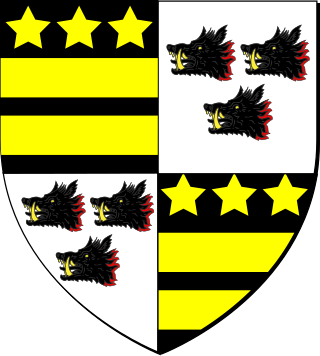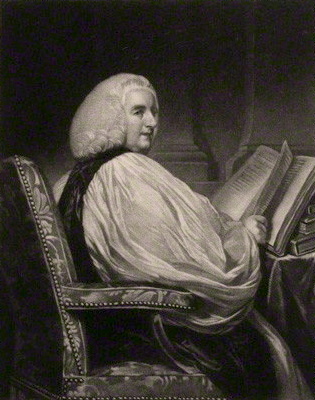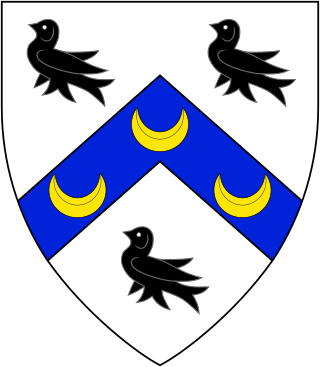
Baron Lyttelton is a title that has been created once in Peerage of England and twice in Peerage of Great Britain, both times for members of the Lyttelton family. Since 1889 the title has been a subsidiary title of the viscountcy of Cobham.

Viscount Cobham is a title in the Peerage of Great Britain that was created in 1718. Owing to its special remainder, the title has passed through several families. Since 1889, it has been held by members of the Lyttelton family.

Earl of Chichester is a title that has been created three times, twice in the Peerage of England and once in the Peerage of the United Kingdom. The current title was created in the Peerage of the United Kingdom in 1801 for Thomas Pelham, 2nd Baron Pelham of Stanmer.

Earl of Lonsdale is a title that has been created twice in British history, firstly in the Peerage of Great Britain in 1784, and then in the Peerage of the United Kingdom in 1807, both times for members of the Lowther family.

Baron Carbery, of Carbery in the County of Cork, is a title in the Peerage of Ireland. It was created in 1715 for George Evans, with remainder to the heirs male of his father and namesake George Evans, a supporter of William and Mary during the Glorious Revolution, who had earlier declined the offer of a peerage. After his elevation to the peerage, Lord Carbery represented Westbury in the House of Commons. He was succeeded by his eldest son, the second Baron. He also sat as Member of Parliament for Westbury. His grandson, the fourth Baron, briefly represented Rutland in Parliament. He was succeeded by his uncle, the fifth Baron. On his death, the line of the eldest son of the first Baron failed. He was succeeded by his first cousin once removed, the sixth Baron, who had previously succeeded his father as second Baronet, of Castle Freke. Lord Carbery sat in the House of Lords as an Irish representative peer from 1824 to 1845. His nephew, the eighth Baron, was an Irish Representative Peer from 1891 to 1894. As of 2014 the titles are held by the latter's great-great-grandson, the twelfth Baron, who succeeded his father in 2012.
There have been three baronetcies created for members of the Anstruther family, two in the Baronetage of Nova Scotia and one in the Baronetage of Great Britain. Two of the creations are extant while one is extinct.

Baron Rokeby, of Armagh in the County of Armagh, was a title in the Peerage of Ireland. It was created in 1777 for The Most Rev. Dr Richard Robinson, Church of Ireland Lord Primate of All Ireland and Lord Archbishop of Armagh, with remainder to his brothers and his father's second cousin Matthew Robinson and the heirs male of their bodies. In 1785 he also succeeded his elder brother as 3rd Baronet according to a special remainder. Lord Rokeby never married and was succeeded in the barony and baronetcy according to the special remainders in the letters patent by his third cousin Matthew Robinson-Morris, the second Baron and fourth Baronet. He was the son of Matthew Robinson, son of Thomas Robinson, son of Sir Leonard Robinson, brother of William Robinson, great-grandfather of the first Robinson Baronet and the first Baron Rokeby. The second Baron was an academic, politician and eccentric. Born Matthew Robinson, he assumed by Royal licence the additional surname of Morris in 1746 on succeeding to the Mount Morris Estate in Monks Horton, Kent through his mother. He never married and was succeeded by his nephew Morris Robinson, the third Baron. He was the elder son of Morris Robinson.

Baron Muncaster was a title in the Peerage of Ireland and in the Peerage of the United Kingdom held by the Pennington family. This family, of Muncaster Castle in Cumberland, descended from William Pennington, who was created a Baronet, of Muncaster in the County of Cumberland, in the Baronetage of England in 1676. He was succeeded by his son, the second Baronet. He represented Cumberland in the House of Commons. His son, the third Baronet, also sat as Member of Parliament for this constituency. He died childless and was succeeded by his younger brother, the fourth Baronet. On his death the title passed to his son, the fifth Baronet. He was Member of Parliament for Milborne Port and Colchester. In 1783, ten years before he succeeded his father in the baronetcy, he was raised to the Peerage of Ireland as Baron Muncaster, with remainder in default of male issue of his own to his younger brother Lowther Pennington and the heirs male of his body.
There have been four baronetcies created for persons with the surname Leslie, one in the Baronetage of Nova Scotia, one in the Baronetage of Ireland, one in the Baronetage of Great Britain and one in the Baronetage of the United Kingdom. Three of the creations are extant as of 2010.
There have been four baronetcies for persons with the surname Blake, one in the Baronetage of Ireland, two in the Baronetage of Great Britain and one in the Baronetage of the United Kingdom. Two of the creations are extant as of 2010. The Blake Baronetcy, of Menlough in the County of Galway, was created in the Baronetage of Ireland on 10 July 1622 for Valentine Blake, Mayor of Galway in 1611 and 1630 and a member of the Irish House of Commons for County Galway. His grandfather Thomas Blake had preceded him as Mayor. The second Baronet was a member of the Irish Parliament for Galway Borough. The third Baronet represented both County Galway and Galway Borough in Parliament. The sixth Baronet was a member of the Irish House of Commons for County Galway. He was the first Catholic gentlemen of distinction to join William of Orange. The twelfth Baronet represented Galway Borough in the British House of Commons. The fourteenth Baronet was high sheriff of County Galway in 1872. See also the Blake Baronetcy of Twizell Castle below.
There have been three baronetcies created for persons with the surname Bellingham, one in the Baronetage of England, one in the Baronetage of Ireland and one in the Baronetage of Great Britain. As of 2014 one creation is extant.

There have been twenty one baronetcies created for persons with the surname Williams, eight in the Baronetage of England, three in the Baronetage of Great Britain and ten in the Baronetage of the United Kingdom. Only six of the creations are extant as of 2017.
There have been seven baronetcies created for persons with the surname Lawrence, one in the Baronetage of England, one in the Baronetage of Great Britain and five in the Baronetage of the United Kingdom.

There have been seven baronetcies created for persons with the surname Watson, one in the Baronetage of England, one in the Baronetage of Great Britain and five in the Baronetage of the United Kingdom. One creation is extant as of 2016.
There have been four baronetcies created for persons with the surname Rich, two in the Baronetage of England, one in the Baronetage of Great Britain and one in the Baronetage of the United Kingdom. As of 2008 three of the creations are extinct while one is dormant.
There have been four baronetcies created for persons with the surname Musgrave, one in the Baronetage of England, one in the Baronetage of Nova Scotia, one in the Baronetage of Ireland and one in the Baronetage of the United Kingdom. As of 2014 two of the creations are extant.
There have been four baronetcies created for persons with the surname Hay, all in the Baronetage of Nova Scotia. Two creations are extinct, one dormant and one extant. A fifth baronetcy in the Jacobite Peerage, although theoretically extant, is not recognised by the Lyon Office.
The Silvester Baronetcy, of Yardley, was a title that was created twice in the Baronetage of the United Kingdom, both times for John Silvester, Recorder of the City of London. The first creation came on 20 May 1815, with normal remainder to the heirs male of his body. The second creation came on 30 March 1822, with remainder in default of male issue of his own to his nephew, Philip Carteret Silvester, son of Rear-Admiral Philip Carteret and Mary-Grace, only sister of Sir John Silvester. The 1815 creation became extinct on Silvester's death in 1822 while he was succeeded in the 1822 creation according to the special remainder by his nephew, the second Baronet. He had earlier the same year assumed by Royal licence the surname of Silvester. This creation became extinct on his death in 1828.
There have been three baronetcies created for people with the surname Moncreiffe or Moncreiff, two in the Baronetage of Nova Scotia and one in the Baronetage of the United Kingdom. Two of the titles are dormant, as the heir has not proved his descent, and one is extant, though its holder does not bear the surname of Moncreiffe.

Sir Edward Tierney, 2nd Baronet was an Irish lawyer and landowner.









